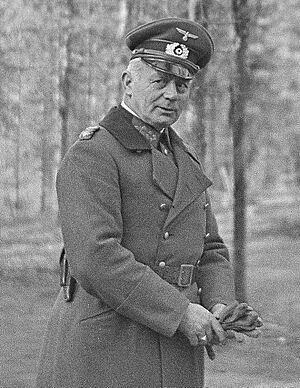Hans Feige facts for kids
Quick facts for kids
Hans Feige
|
|
|---|---|

Hans Feige, Finland 1941.
|
|
| Born | 10 November 1880 Königsberg, East Prussia, Germany |
| Died | 17 September 1953 (aged 72) Bad Schussenried, Baden-Württemberg, Germany |
| Allegiance | |
| Service/ |
|
| Years of service | 1900–42 |
| Rank | General der Infanterie |
| Commands held | 1st Cavalry Division XXXVI. Gebirgs-Armeekorps |
| Battles/wars | World War I World War II
|
| Awards | Iron Cross German Cross |
Hans Feige (born November 10, 1880 – died September 17, 1953) was a high-ranking German army leader during World War II. He held the rank of General of the Infantry in the Wehrmacht, which was Germany's armed forces at the time.
Contents
A Military Career Begins
Hans Feige joined the German Army in 1900. This was before World War I began. During World War I, he worked in important planning roles for different army groups. He was injured twice during the war. For his bravery, he received several awards, including the Iron Cross.
After World War I ended, he joined a group of former soldiers. Later, he became part of the Reichswehr, which was the German army between the two World Wars. Here, he continued to work in planning roles. He was promoted to a senior general rank in 1931 and again in 1933. In 1933, he took charge of the 1st Cavalry Division. This unit was later disbanded in 1935. He then retired from active service.
World War II and Key Operations
When World War II started, Hans Feige was called back to duty. In May 1940, he took command of the XXXVI Corps. His unit then took part in the Battle of France in the Lorraine area.
After this, his corps moved to Norway. To prepare for Operation Barbarossa, which was Germany's invasion of the Soviet Union, his corps moved into central Finland. When the German attack began on June 22, 1941, his unit worked with the Finnish army. Their mission was to recapture a town called Salla. They also aimed to cut off Murmansk, an important port city, from the rest of Russia. This mission was part of an operation called Operation Arctic Fox.
Feige's forces did recapture Salla. However, their advance soon stopped. This was because his troops were not well-equipped for the harsh conditions. Despite pressure from his commander, Nikolaus von Falkenhorst, the offensive did not make much progress. The attack was finally called off on September 17, 1941.
Later Years and Retirement
In November 1941, Hans Feige was removed from his command. Another general, Karl Weisenberger, took his place. Feige was then placed into the Führerreserve. This meant he was put on standby and did not receive any new active commands. Because he was no longer active, he officially retired on June 30, 1942.
Awards and Decorations
- Iron Cross of 1914, 1st and 2nd class
- German Cross in Gold
- Grand Cross of the Order of the White Rose of Finland with swords
Images for kids


